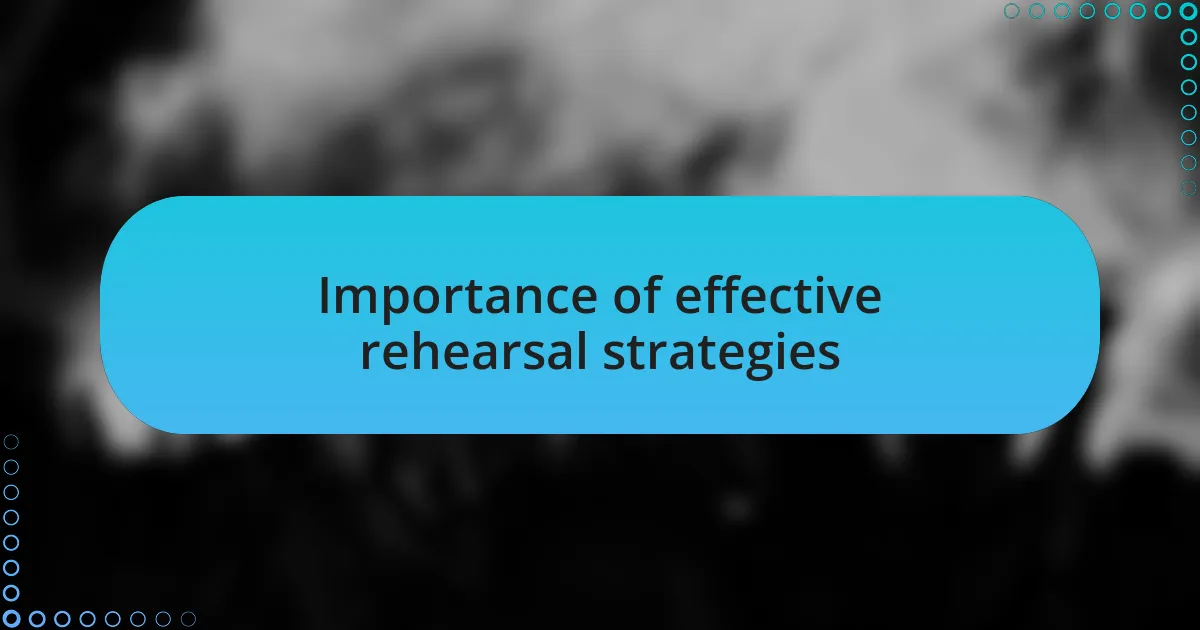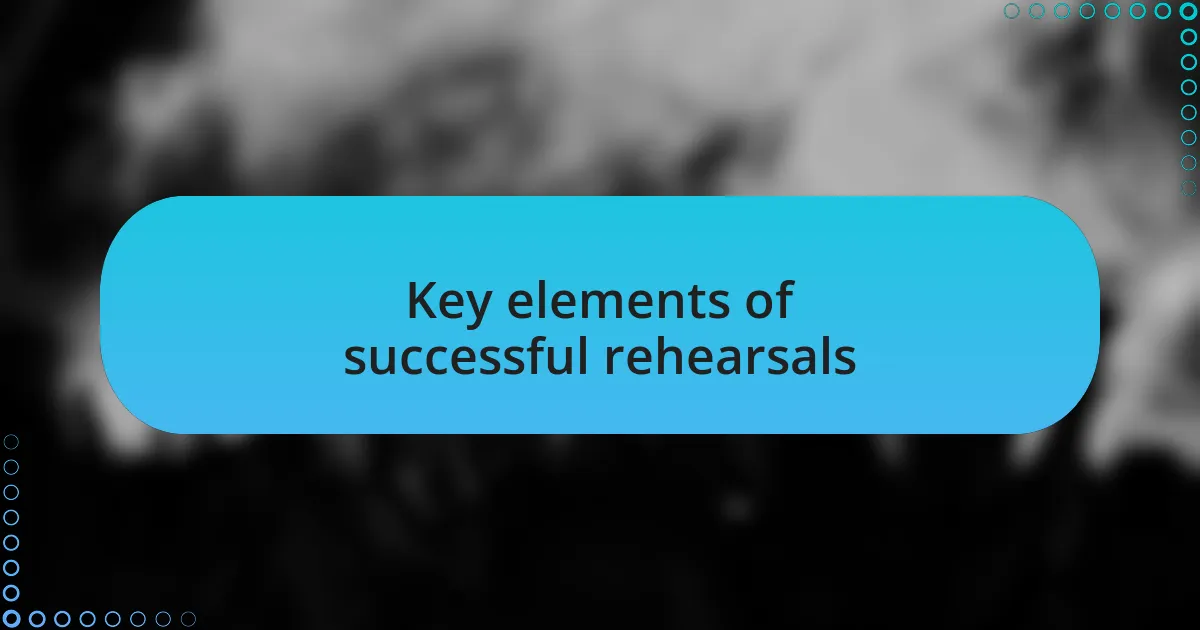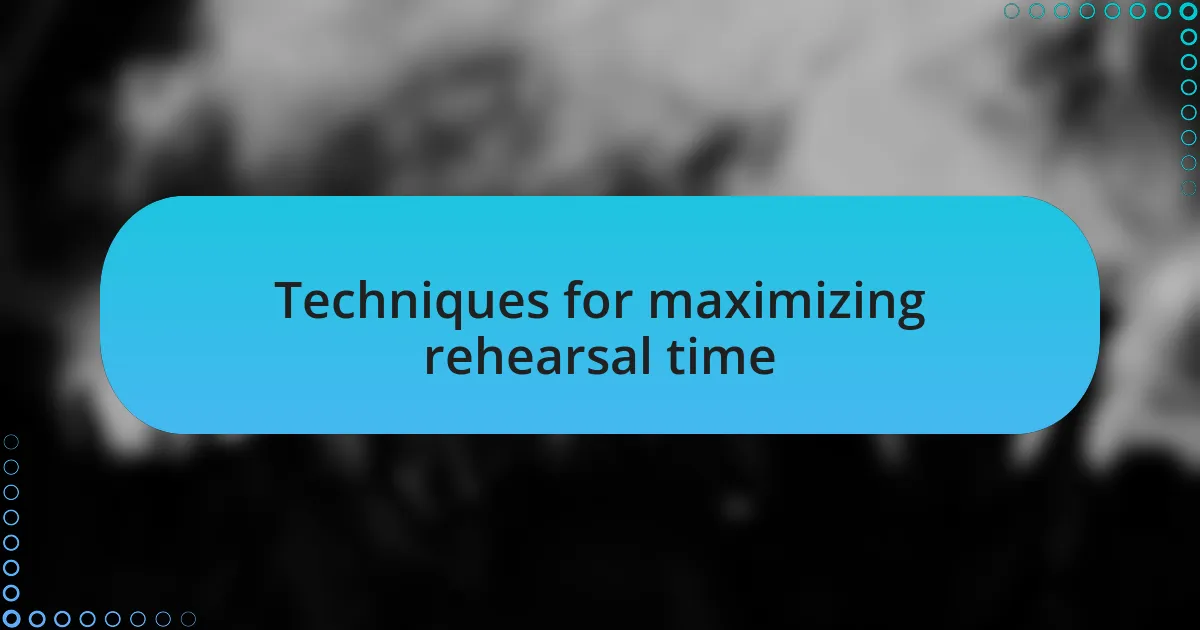Key takeaways:
- Rehearsal success hinges on creating shared musical experiences, clear goal-setting, and constructive feedback.
- Implementing structured rehearsal strategies, such as warm-ups and rotating leadership roles, can enhance collaboration and creativity.
- Effective communication and fostering a supportive environment are crucial for improving rehearsal outcomes and building group cohesion.
- Utilizing techniques like recording sessions and revisiting previous songs helps identify improvements and reinforces learning over time.

Understanding rehearsal success
Rehearsal success is more than just hitting the notes; it’s about creating a shared experience. I remember one particular rehearsal where we struggled to find our groove, but when we finally clicked as a group, it felt like magic. Have you ever felt that rush when everyone is in sync? That’s the essence of success – it’s those moments of connection that truly define our progress.
Another critical aspect of understanding rehearsal success is setting clear goals. I’ve often found that when my band and I outline specific objectives for each session, it transforms the atmosphere entirely. It’s easier to stay focused and motivated when everyone knows what we’re aiming for. What goals have you set for your rehearsals lately, and how do they shape your experience?
Lastly, let’s talk about the importance of feedback. I used to think that positive reinforcement was all we needed, but I’ve learned that constructive criticism is invaluable. During one rehearsal, a bandmate pointed out a rhythm that we were consistently missing. Initially, it stung, but it ultimately led us to a stronger performance. How do you approach feedback within your group? Embracing it can lead to breakthroughs you never expected.

Importance of effective rehearsal strategies
Effective rehearsal strategies are the backbone of any successful music journey. I recall a time when my band decided to implement structured warm-ups before each session. The difference was palpable. Everyone felt more prepared and energized, which set a positive tone for the entire rehearsal. Have you ever experienced that shift in mood when you start off on the right foot? It’s remarkable how a simple routine can ignite that spark of creativity.
One of the most enlightening moments in my rehearsal experience came when we tried rotating leadership roles during practice. This change not only brought fresh perspectives but also built a deeper sense of ownership among the members. Each of us learned to communicate our artistic visions more clearly. Have you explored ways to empower your bandmates? It can open up new avenues of collaboration and strengthen your collective sound.
I’ve also found that taking time to reflect on our progress after each rehearsal is crucial. There was a specific instance where we recorded a session and reviewed it later. Listening back, I was surprised at how much insight we gained from that exercise. It also sparked conversations about our strengths and areas for improvement. How often do you take time to assess your own progress? Engaging in this practice can turn each rehearsal into a powerful learning opportunity.

Key elements of successful rehearsals
Effective communication is one of the key elements of successful rehearsals. I remember a time when we struggled to sync our playing, leading to frustration. It wasn’t until we made a conscious effort to discuss our goals and challenges openly that our cohesion improved. How often do you check in with your bandmates to ensure everyone is on the same page? Establishing a culture of honest dialogue can transform your practice sessions.
Another critical element is setting specific goals for each rehearsal. I once found myself entering practices without a clear focus, which led to disorganized sessions. After implementing a shared agenda, we began to tackle specific songs or techniques intentionally. Have you ever walked away from a rehearsal and felt like you hadn’t accomplished anything? By having well-defined objectives, each member can contribute to a more fruitful and rewarding experience.
Finally, fostering a supportive atmosphere is paramount. I recall a night when one of my bandmates was feeling particularly anxious about a solo. Instead of dismissing the concerns, we spent extra time working through it together. That camaraderie not only boosted their confidence but also strengthened our bond as a group. How do you encourage a nurturing environment in your rehearsals? A little encouragement can make all the difference in how everyone approaches their craft.

Creating a structured rehearsal plan
Creating a structured rehearsal plan starts with outlining the specific areas you want to focus on. In my experience, I’ve found that dedicating parts of the session to warm-ups, new material, and refining existing songs helps keep us organized. Have you ever noticed how easily time can slip away when there’s no plan? By clearly allocating time slots, we turn what could be chaotic practices into well-oiled machines.
One method that has worked wonders for me is the ‘30-60-90’ rule. This means breaking down our rehearsal into three segments: 30 minutes for warm-ups, 60 minutes for new material, and 90 minutes for polishing what we already know. I remember when we first adopted this structure; we made significant strides in improving our sound within a single session. How can a simple time structure dramatically enhance your rehearsals? It aligns everyone’s focus and efforts toward tangible outcomes.
Finally, regularly revisiting and adjusting your rehearsal plan can lead to continuous improvement. I’ve learned the hard way that sticking rigidly to a plan without reflection can create stagnation. After every rehearsal, I like to ask my bandmates for feedback on what worked and what didn’t. Would you be open to hearing the thoughts of your band? This reflection not only helps us refine our strategy but also fosters a sense of collaboration, making every practice feel more dynamic and responsive.

Techniques for maximizing rehearsal time
One technique I swear by is the “circle back” method, where we periodically revisit songs we’ve previously rehearsed. This not only keeps those pieces fresh in our minds but also allows us to identify areas for improvement that might have gone unnoticed initially. I still remember the shock I felt when we revived a song that we hadn’t played in months, only to realize we had evolved as musicians, bringing new energy and creativity to it. Have you ever played a song and discovered something completely new in it?
Another effective approach is incorporating the use of recording equipment during rehearsals. I’ve had moments where listening back to our sessions revealed surprising details – things that I didn’t catch while we were in the moment. It’s like having a personal coach that doesn’t miss a beat. When you hear yourself and your bandmates without the pressure of performing live, you can pinpoint specific rhythm issues or harmonization flaws better than just by playing. Can you imagine how much you could learn from just one recording?
Finally, I always emphasize the importance of setting clear, achievable goals for each rehearsal. For instance, during one particularly challenging period, we aimed to master a difficult song section by the end of the rehearsal. The thrill of accomplishing that goal as a band was incredibly motivating, turning what might have felt like a mundane practice into a triumphant experience. What goals could you set to transform your own rehearsals into a sense of achievement?

Personal reflections on rehearsal experiences
Reflecting on my rehearsal experiences, I can’t help but think of that one night when everything seemed to fall into place. We had been struggling with a particular song, and as we rehearsed, the energy in the room shifted. Suddenly, we were not just playing notes; we were telling a story together. Have you ever felt that moment when your band truly connects, turning practice into something magical?
Another vivid memory comes to mind involving our collaborative spirit. One day, we faced some pushback on a musical arrangement. Instead of letting it divide us, we decided to jam about it, and that free-form exploration birthed a revised version that excited everyone. I realized then how important it is to create a safe space for ideas. Haven’t you found that the best breakthroughs often happen when you least expect them?
Lastly, I’ve learned that vulnerability during rehearsals can lead to growth. Sharing my uncertainties about a specific solo allowed my bandmates to support me in ways I hadn’t anticipated. Their encouragement opened up a dialogue, fostering not only my confidence but also our collective sound. Isn’t it fascinating how our individual experiences can strengthen the whole group?